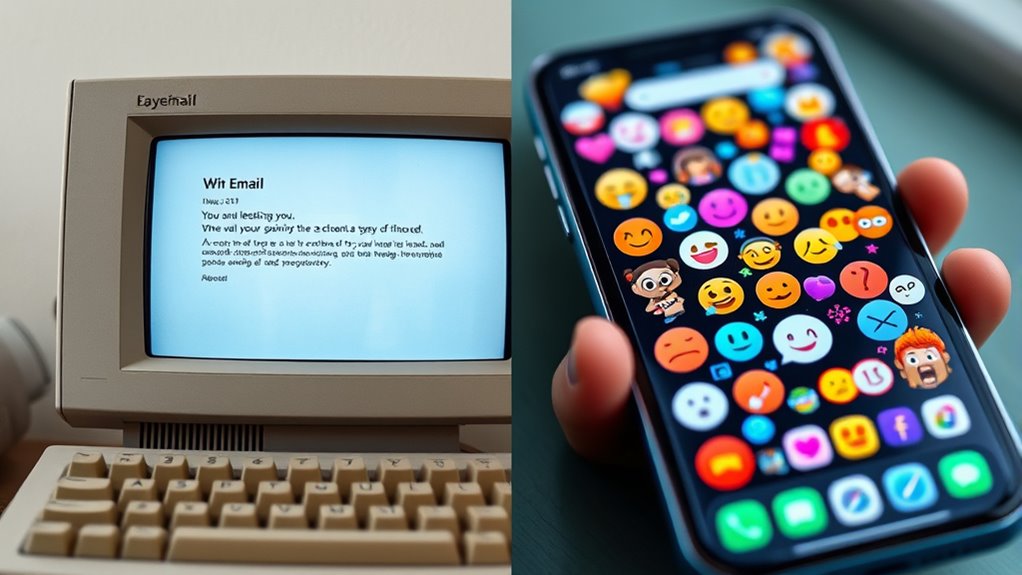When emailing Boomers versus Millennials, you’ll notice key differences in tone, formality, and responsiveness. Boomers prefer formal language, quick replies, and detailed messages, while Millennials lean toward casual tone, brevity, and patience with slower responses. Visual elements like emojis appeal more to Millennials, whereas Boomers prioritize clarity and security. Understanding these nuances helps you communicate effectively across generations—keep exploring to uncover more insights on how styles truly shift.
Key Takeaways
- Tone and language vary, with Boomers favoring formal, respectful emails and Millennials preferring casual, friendly communication.
- Visual elements like emojis and GIFs are common in Millennials’ messages but generally avoided by Boomers.
- Response expectations differ: Boomers prefer quicker replies within hours, while Millennials are more patient with longer response times.
- Email length and detail differ, with Boomers favoring concise, straightforward messages and Millennials expecting more comprehensive information.
- Technological comfort impacts email style; Boomers may face accessibility challenges, while Millennials adapt easily to new tools and features.
Generational Attitudes Toward Email Formality

While both Boomers and Millennials use email regularly, their attitudes toward formality often differ. Boomers tend to prefer formal language, especially in professional settings, using polite greetings and proper titles. They see email as a reflection of respect and professionalism, so slang usage is generally avoided. Millennials, on the other hand, are more comfortable with a relaxed tone. They might start emails with casual greetings and incorporate informal language, even in work-related messages. Formal language isn’t always necessary for them, and they often see emails as a quick way to communicate rather than a formal exchange. This difference shapes how each generation approaches email, influencing everything from opening lines to overall tone and the use of slang versus traditional language.
Variations in Email Tone and Language Choices

Different generations approach the tone and language of emails in distinct ways, shaping how you communicate effectively. Boomers often favor a tone of professionalism, using formal language and avoiding email humor to maintain respect. Millennials, however, tend to adopt a more casual tone, incorporating friendly language and sometimes light email humor to build rapport. This difference influences your choice of words, where Boomers may prefer clear, straightforward messages, while Millennials might include more conversational phrases. Recognizing these variations helps you craft emails that resonate with your audience. Adjusting your tone to match their expectations ensures your message is received positively. Whether you aim for professionalism or a relaxed vibe, understanding these language choices enhances your overall communication strategy. Additionally, being aware of communication styles can help you navigate and adapt to each generation’s preferences more effectively.
Differences in Response Expectations and Timing

You might notice that Boomers often expect quicker responses and prefer more immediate communication, while Millennials tend to be more patient and comfortable with longer wait times. Your response speed may need to adapt depending on who you’re emailing, as their patience levels and communication paces differ. Understanding these expectations helps you manage each interaction effectively and avoid unnecessary frustration.
Response Time Expectations
Have you ever noticed how quickly Boomers expect to hear back from an email, often within a few hours or by the end of the day? Their response time expectations stem from a lower level of digital impatience, valuing promptness and clarity. Millennials, on the other hand, are typically more relaxed about response times, understanding that replies may take longer. This difference can cause frustration or miscommunication. Recognizing customer engagement patterns related to response times can help tailor communication strategies more effectively.
- You might feel anxious waiting for a response, fearing you’re being ignored.
- You could perceive slow replies as disrespect or disinterest.
- You may feel pressured to check your inbox constantly.
- Or, you might appreciate a more relaxed pace, feeling less stressed about immediate responses.
Understanding these response time expectations helps you navigate digital conversations smoothly.
Preferred Communication Paces
While response time expectations vary, communication pace often reflects each generation’s comfort level with digital interactions. Boomers tend to prefer a slower pace, valuing email etiquette that emphasizes clarity and professionalism. They often expect thoughtful responses within a reasonable timeframe, focusing on message personalization to build trust and rapport. Millennials, on the other hand, usually favor quicker exchanges, valuing immediacy and brevity. They’re accustomed to rapid communication, often blending personal and professional contexts seamlessly. When emailing, adapt your message personalization to match these preferences: be more formal and detailed for Boomers, and concise yet friendly for Millennials. Recognizing these differences helps you set realistic expectations and fosters smoother, more effective communication across generations. Understanding communication styles can further improve interactions by aligning your approach with each group’s expectations.
Patience Levels Vary
Different expectations around response times highlight how patience levels vary between Boomers and Millennials. Boomers often have higher patience expectations, anticipating quicker replies and valuing prompt communication. Millennials, however, tend to accept longer response timing, understanding that inboxes can be busy. This difference can influence your email strategy and how you interpret responses.
Be aware that:
- You might feel frustrated waiting for a reply from a Boomer.
- Millennials may take days to respond without concern.
- Patience expectations shape your perception of professionalism.
- Misjudging response timing can cause unnecessary tension.
Understanding these patience levels helps you avoid miscommunication and manage expectations more effectively, ensuring smoother interactions regardless of generational differences.
Preferred Email Length and Detail Level

You’ll find that Boomers prefer concise emails with clear, straightforward information, while Millennials often appreciate more detailed messages. As expectations for detail shift, it’s important to guarantee your email length to your audience’s preferences. Prioritizing clarity over complexity helps ensure your message resonates effectively. Understanding communication preferences can further enhance your email effectiveness across different age groups.
Length Preferences Vary
Preferences for email length and detail level vary considerably between Boomers and Millennials. You might notice that Boomers prefer shorter, straightforward messages, valuing quick clarity. Meanwhile, Millennials often favor more detailed emails that provide context and thorough information. This difference impacts how you craft your message:
- You could cause frustration if your message is too long or too brief.
- An overly detailed email may overwhelm Boomers and turn them off.
- A brief email might leave Millennials feeling undervalued or under-informed.
- Balancing message detail with conciseness can foster better engagement across generations.
- Recognizing generational communication preferences helps in tailoring your emails for maximum effectiveness.
Understanding these preferences guarantees your email length resonates. Whether you’re aiming for brevity or depth, tailoring your message detail to these generational tendencies boosts your communication effectiveness.
Detail Expectations Shift
As communication styles evolve, expectations around email length and detail have shifted between Boomers and Millennials. Boomers often prefer longer emails with detailed information, valuing thoroughness for message clarity. Millennials, however, favor concise messages that get straight to the point, reflecting a preference for quick, efficient email etiquette. This difference impacts how you craft your messages. Use the table below to see the contrast:
| Aspect | Boomers | Millennials |
|---|---|---|
| Preferred Length | Longer, detailed emails | Short, to-the-point emails |
| Focus on Content | Detail and context | Clarity and brevity |
| Approach to Email | Formal and comprehensive | Informal and succinct |
Adjust your email style based on your audience to ensure message clarity and respect their expectations. Additionally, understanding email etiquette can help bridge communication gaps across generations.
Clarity Over Complexity
While providing enough detail is important, prioritizing clarity over complexity guarantees your message resonates. Keeping your emails clear aligns with good email etiquette and ensures your audience understands your intent. Overloading messages with unnecessary information can cause confusion and frustration, especially for Boomers and Millennials with different preferences. Focus on delivering concise, straightforward content that gets to the point quickly. Remember, an email that’s easy to read and understand fosters trust and encourages a prompt response. Highlighting quality and flavor in your communication can help set expectations clearly.
- Feel confident your message is understood without ambiguity
- Reduce the chance of misinterpretation or miscommunication
- Show respect for your recipient’s time and attention
- Build stronger connections through transparent communication
Use of Emojis, GIFs, and Visual Elements

Boomers and Millennials differ considerably in their use of emojis, GIFs, and visual elements in digital communication. Millennials tend to incorporate more emoji usage to express tone and emotion, enhancing visual engagement. They see emojis and GIFs as a way to add personality and warmth to their messages, making interactions feel more authentic and lively. In contrast, Boomers generally prefer plain text or minimal visual elements, viewing emojis as unnecessary or informal. When you communicate via email, understanding these preferences can help you craft messages that resonate. For Millennials, adding a well-placed emoji or GIF can boost engagement and clarity. However, with Boomers, sticking to clear, straightforward language without visual embellishments often proves more effective. Tailoring your visual approach improves communication across generations.
Privacy Concerns and Data Security Perspectives

Understanding privacy concerns and data security perspectives varies markedly between Boomers and Millennials. You might worry about data breaches exposing sensitive information, or whether email encryption keeps your messages safe. Boomers often prioritize privacy, fearing identity theft and demanding secure, trusted platforms. Millennials, however, tend to be more comfortable sharing personal info but still value data security. Consider these emotional impacts:
- Fear of losing control over personal information
- Anxiety about unauthorized access to email accounts
- Distrust in companies handling data breaches
- Concerns over persistent digital footprints
Both groups care about safeguarding their data, but their perspectives shape how they approach email security. Recognizing these differences helps tailor communication strategies that respect their privacy priorities and build trust.
Technological Comfort and Accessibility Factors

Technological comfort and accessibility considerably influence how Boomers and Millennials engage with email communication. If you’re more digitally literate, you find it easier to navigate email platforms and understand features, making your experience smoother. Boomers often face accessibility barriers, like small fonts or complicated interfaces, which can hinder their ability to use email effectively. Conversely, Millennials tend to be more comfortable with technology, adapting quickly to new tools and updates. Your level of digital literacy shapes how confident you feel sending, reading, or managing emails. Accessibility factors directly impact engagement—if interfaces aren’t user-friendly, both groups may avoid email altogether. Additionally, the role of advanced display technology like high-resolution screens can influence how easily users read and interpret email content, especially for those with visual impairments. Understanding these differences helps tailor communication strategies that bridge the gap and ensure everyone can connect effortlessly.
Frequently Asked Questions
How Do Email Subject Line Preferences Differ Across Generations?
You might notice that email subject line preferences vary across generations. Younger audiences often prefer catchy, personalized strategies with a casual tone, while older groups favor clear, straightforward language with a professional tone. To engage each, craft subject lines that match their tone preferences and incorporate personalization strategies. This approach guarantees your message resonates, increases open rates, and builds stronger connections across diverse age groups.
Are There Specific Times of Day When Each Generation Prefers to Email?
You might wonder about the best emailing hours for different generations. Typically, Boomers prefer to check emails during mid-morning or early afternoon, aligning with peak engagement times. Millennials often respond better to late morning or early evening emails, when they’re more active online. To maximize open rates, aim for these peak engagement times, but remember, testing your audience’s habits helps refine your email schedule for ideal results.
How Do Generational Differences Influence Email Attachment Preferences?
When considering attachment etiquette and file format preferences, your approach should adapt to your recipient’s generation. Boomers often prefer straightforward, universally compatible formats like PDFs, valuing clarity and professionalism. Millennials might be more open to diverse formats, but still appreciate clear, concise attachments. You should always prioritize easy-to-open files, keep attachment sizes reasonable, and follow best practices to guarantee your email communicates effectively across generational boundaries.
What Are Common Misunderstandings Between Boomers and Millennials in Email Communication?
Imagine a bridge with two distinct sides—each representing a generation’s unique tone. You might assume Boomers prefer formal email etiquette, while Millennials favor casual exchanges, but misunderstandings often arise from this. You may think their tone signals disrespect or disinterest, but it’s simply different communication styles. Recognizing these differences helps you navigate email etiquette more effectively, fostering clearer understanding and stronger connections across generations.
How Does Cultural Background Intersect With Generational Email Habits?
You’ll find that cultural background heavily influences email habits through unique cultural nuances and communication styles. You might notice that some cultures prefer formal language and indirect messaging, while others value directness and brevity. When you adapt your email tone to match these cultural nuances, your messages become clearer and more respectful, fostering better understanding. Recognizing these differences helps you communicate more effectively across diverse cultural and generational backgrounds.
Conclusion
Think of email communication as a bridge connecting generations. While Boomers may prefer sturdy, formal planks, Millennials might add colorful flags and emojis to make the journey lively. Understanding these subtle differences helps you navigate the digital landscape with confidence, ensuring your message resonates across time. Embrace the symbolism—each email is a thread in the tapestry of connection, weaving together tradition and innovation into a seamless conversation that spans generations.









